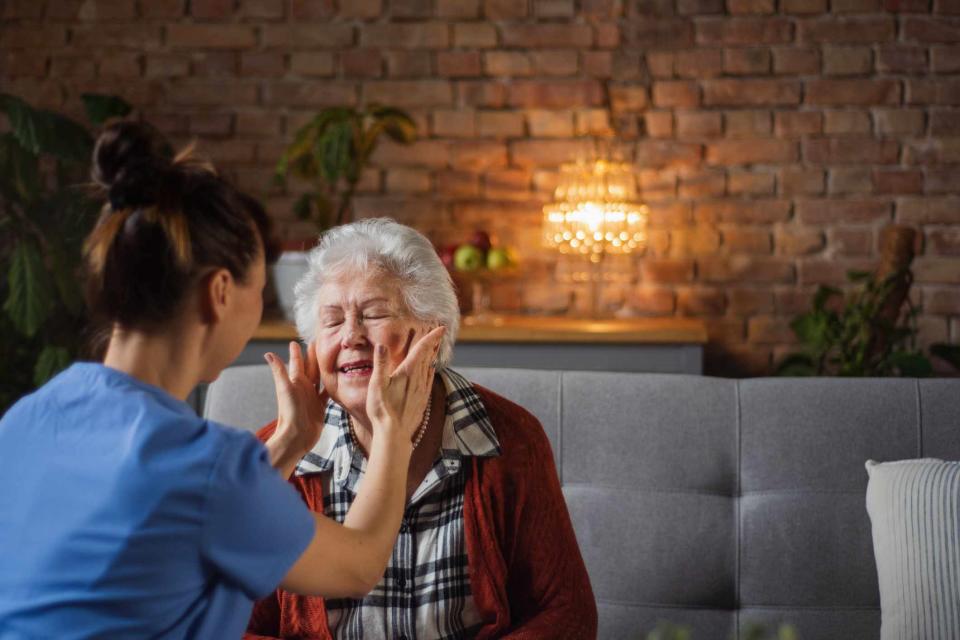Lopsided Smile: Everything You Need to Know
It can be a long-term or short-term problem

Halfpoint Images / Getty Images
Medically reviewed by Rony Kampalath, MD
A crooked or uneven smile is fairly common—most people do not have complete symmetry to their face. However, a crooked smile can mean there is a medical problem, and in some cases it can be an emergency. There are many possible reasons for a crooked smile, and most are not dangerous. However, a sudden change requires urgent medical attention.
This article will discuss the possible meanings of a crooked smile, the significance of a sudden lopsided smile, and when to see a healthcare provider.

Halfpoint Images / Getty Images
Lopsided Smile Causes
A crooked smile can mean a variety of issues like dental problems, nerve damage, stroke, and more. Usually, the different causes are associated with additional symptoms besides a lopsided smile.
Stroke
A stroke is a serious type of brain damage that occurs due to an interrupted blood supply in an artery of the brain. Among other symptoms, it can cause weakness of the face and body on one side.
Symptoms from a stroke appear suddenly and it is a medical emergency. The acronym "FAST" stands for facial drooping, arm weakness, speech difficulties, and time to call emergency services.
Related: An Overview of Stroke
Bell’s Palsy
This type of facial weakness or paralysis affects one side of the face. Common symptoms affecting the mouth are that one corner of your mouth will droop and the smile line (nasolabial fold) will disappear. There will also be weakness in the forehead, eyelid, and cheek on that side of the face.
Bell's palsy develops over the course of a few hours and worsens for a few days. After a couple of weeks, it begins to improve gradually, often taking three to six months to get back to normal.
The causes of Bell's palsy are not known. It often improves on its own, and sometimes oral steroids can help speed up recovery.
Learn More: What Is Bell's Palsy?
Facial Paralysis
Facial movements can become paralyzed (weak) due to nerve or muscle damage. Besides Bell’s palsy, stroke, and nerve injury, a few other causes of facial weakness include:
Myasthenia gravis: A condition in which the immune system mistakenly attacks receptors needed to activate muscles
Multiple sclerosis: A condition in which the immune system mistakenly attacks the protective myelin sheath of nerves in the brain, spinal cord, and eyes
Amyotrophic lateral sclerosis: A disease that attacks the nerves that control movement
Uneven Teeth
Many people naturally have mildly or moderately uneven teeth. This typically does not cause a crooked smile. Sometimes teeth are naturally very uneven or become severely uneven due to dental conditions such as tooth decay. This can cause a smile to appear crooked.
Misaligned Jaw
The jaw structure can cause a lopsided smile if the bones or movement of the jaw are formed unevenly or become damaged due to trauma or disease (such as cancer invading the bone).
Surgery
Surgery may cause damage to the nerve branches that control mouth movements. This can occur when surgery is necessary for removal of a tumor or abscess that has grown into the facial nerve. And sometimes a surgical error can result in accidental transection (cutting) or a nerve or nerve branch.
Aging
For some people, aging can lead to an uneven smile. This can occur as a result of wrinkles, dental issues, nerve damage, or stroke.
Smoking
Smoking may lead to mouth diseases, such as severe tooth decay, gum disease, or oral cancer. This can cause a crooked smile.
Trauma
An injury to the face can cause damage to the nerves, muscles, bones, or other tissues. Swelling can be substantial as well. This can cause a lopsided smile and an uneven appearance of the face.
After the swelling goes down and healing is complete, the face and smile can partially or fully return to normal. With severe trauma, a crooked smile can remain for the long term.
Torticollis
Torticollis is a movement disorder that causes involuntary (not on purpose) spasms and twisting of the neck. The muscles can spasm for prolonged periods, sometimes resulting in a crooked smile. This condition may be present from birth and can be associated with certain birth defects.
Associated Symptoms
Symptoms associated with a lopsided smile can include:
Flattening of the nasolabial fold (the angled crease at the bottom of your cheeks, near your nose)
Slurred speech
Trouble chewing or swallowing
An eyelid that can’t fully close
Sudden Lopsided Smile
A sudden lopsided smile can be a sign of a stroke, brain aneurysm (a bulge in the wall of an artery), or an infection. This may develop over the course of hours. Rarely, a new and rapidly worsening lopsided smile can be a sign of a tumor, cancer metastasis (spreading of cancer), or a seizure (uncontrolled electrical activity in the brain).
What to Do If You Think Someone Is Having a Stroke
If you think someone is having a stroke, call 911 and stay with them until emergency help arrives. If possible, describe what you witnessed when emergency healthcare providers arrive.
Related: What to Do (and Not Do) If Someone Is Having a Stroke
When to See a Healthcare Provider
If your face or mouth suddenly feels numb or if movement seems uneven, this means that you should get medical attention right away.
Symptoms associated with an uneven smile that require urgent medical attention include:
Sudden, severe headache
Weakness on one side of the body
Loss of balance
Vision changes
Facial drooping on one side
Slurred speech
Traumatic injury
Swelling of the face or neck
Inability to control facial movements
Spasms of the face or neck
Pain of the eye or an infection of the eye
Treatment
There are different techniques that can be used for treatment of an uneven smile. Immediate treatment differs from delayed treatment.
During an emergency situation, such as a stroke or severe facial trauma, the immediate treatment involves preventing serious damage and reducing the long-term effects. This may include interventions such as blood thinners for stroke treatment or surgery for treatment of facial trauma.
After a lopsided smile has stabilized, treatment can include exercises to train the muscles. This can be directed to improve the facial appearance, as well as to prevent complications, such as choking.
In some situations, injections of Botox (botulinum toxin) can work to paralyze certain muscles to prevent a crooked appearance of the mouth.
And sometimes surgical intervention may be necessary to reconstruct the facial nerves, muscles, bone, or other structures. This can help to even out the appearance of the face. This type of surgery may also be effective for reducing the risk of certain complications, like eye damage due to an eyelid that doesn’t properly close.
Summary
A crooked smile can mean many different medical problems. Sometimes, a person’s smile is uneven due to normal variations, and it isn’t usually anything to worry about. But sometimes, a crooked smile can mean there is a serious medical issue, such as a stroke or an infection.
It’s important to get prompt medical attention for any sudden change in facial appearance. Other causes, such as Bell’s palsy or a misaligned jaw, may need medical intervention and management to prevent complications.
Frequently Asked Questions
What are the initial signs of Bell’s palsy?
Generally, Bell’s palsy starts with stiffness or weakness of the face, including the eyelids. Blinking your eyes may feel uneven, or you might have a sensation of dryness in one of your eyes. Sometimes it can be hard to chew on one side, and your smile looks very uneven.
The condition usually causes profound paralysis of one side of the face, including an inability to raise your eyebrow on one side. With Bell’s palsy, the face moves unevenly, and the sides of the face look uneven while you are resting your face.
When should I be concerned about a sudden lopsided smile?
You should get medical attention if it is new, if it happens suddenly, or if the unevenness is severe. Complications can also be concerning, even if the cause is not dangerous.
Complications may include corneal damage (to the outer layer of your eye), visual problems (due to a droopy eyelid), and the risk of choking due to chewing and swallowing problems.
What are the signs of a stroke?
Common signs of a stroke include sudden weakness of one side of the face and/or body, trouble speaking or understanding language, loss of balance, dizziness, or confusion. Get prompt medical attention if you or someone else experiences these symptoms.
